U.S. Livestock & Meat Trade Update – Aug ’20
Executive Summary
U.S. livestock and meat trade figures provided by the USDA were recently updated with values spanning through Jun ’20. Highlights from the updated report include:
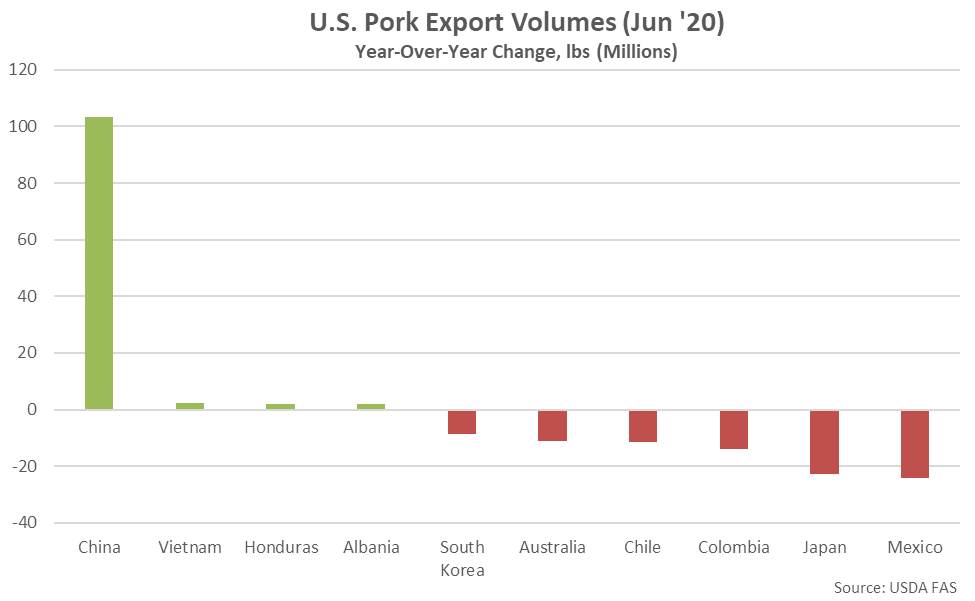 Mexico and Japan have historically been the largest importers of U.S. pork products, accounting for nearly half of the total U.S. pork export volumes throughout the past five years. Combined U.S. pork export volumes destined to Mexico and Japan have declined by 2.9% on a YOY basis throughout the past 12 months, however. Throughout the past 12 months, YOY increases in U.S. pork exports have been led by product destined to China, Hong Kong & Taiwan, while shipments destined to South Korea have declined most significantly on a YOY basis over the period.
Mexico and Japan have historically been the largest importers of U.S. pork products, accounting for nearly half of the total U.S. pork export volumes throughout the past five years. Combined U.S. pork export volumes destined to Mexico and Japan have declined by 2.9% on a YOY basis throughout the past 12 months, however. Throughout the past 12 months, YOY increases in U.S. pork exports have been led by product destined to China, Hong Kong & Taiwan, while shipments destined to South Korea have declined most significantly on a YOY basis over the period.
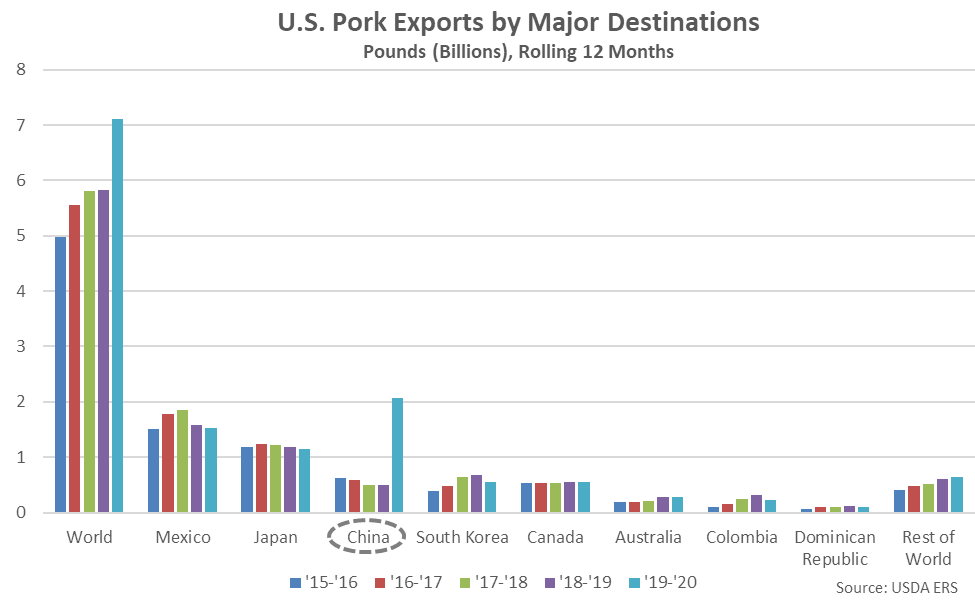 U.S. pork import volumes finished higher on a YOY basis for the second consecutive month during Jun ’20, increasing by 8.8%. Pork import volumes had finished lower on a YOY basis over 24 consecutive months prior to the two most recent increases. The increase in pork export volumes more than offset the increase in import volumes, resulting in U.S. net pork trade finishing up 2.3% YOY during Jun ’20, reaching a record high seasonal level. The YOY increase in net pork trade was the 14th experienced in a row but the smallest experienced throughout the period.
’18-’19 annual net pork trade increased 5.6% YOY, finishing at a record high level for the second consecutive year. ’19-’20 YTD net pork trade has increased an additional 30.8% on a YOY basis throughout the first three quarters of the production season.
U.S. pork import volumes finished higher on a YOY basis for the second consecutive month during Jun ’20, increasing by 8.8%. Pork import volumes had finished lower on a YOY basis over 24 consecutive months prior to the two most recent increases. The increase in pork export volumes more than offset the increase in import volumes, resulting in U.S. net pork trade finishing up 2.3% YOY during Jun ’20, reaching a record high seasonal level. The YOY increase in net pork trade was the 14th experienced in a row but the smallest experienced throughout the period.
’18-’19 annual net pork trade increased 5.6% YOY, finishing at a record high level for the second consecutive year. ’19-’20 YTD net pork trade has increased an additional 30.8% on a YOY basis throughout the first three quarters of the production season.
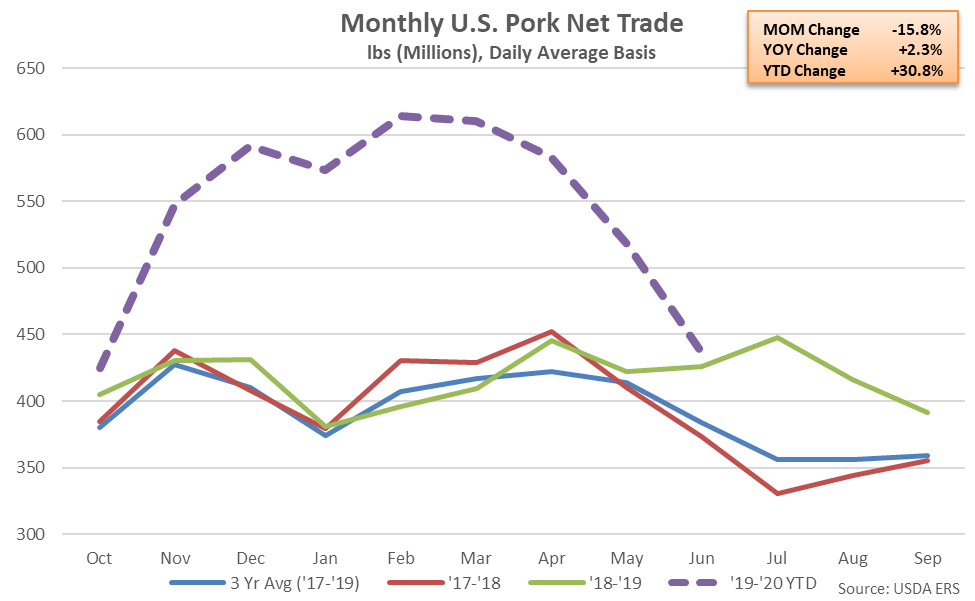 Beef & Veal – Exports Decline to an 11 Year Seasonal Low Level, Net Trade Remains Negative
U.S. beef & veal export volumes declined on a YOY basis for the third consecutive month during Jun ’20, finishing down 33.0% and reaching an 11 year seasonal low level. The YOY decline in beef & veal export volumes was the largest experienced throughout the past 15 years on a percentage basis. YOY declines in U.S. beef & veal export volumes were led by shipments destined to South Korea, followed by shipments destined to Mexico and Japan, while export volumes destined to New Zealand finished most significantly higher on a YOY basis throughout the month.
Beef & Veal – Exports Decline to an 11 Year Seasonal Low Level, Net Trade Remains Negative
U.S. beef & veal export volumes declined on a YOY basis for the third consecutive month during Jun ’20, finishing down 33.0% and reaching an 11 year seasonal low level. The YOY decline in beef & veal export volumes was the largest experienced throughout the past 15 years on a percentage basis. YOY declines in U.S. beef & veal export volumes were led by shipments destined to South Korea, followed by shipments destined to Mexico and Japan, while export volumes destined to New Zealand finished most significantly higher on a YOY basis throughout the month.
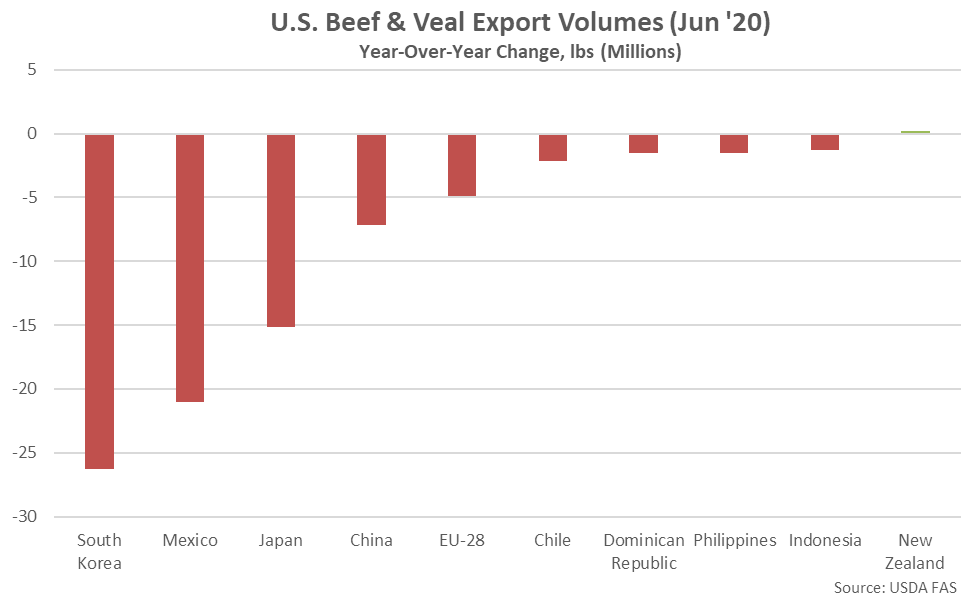 Japan, South Korea, China, Hong Kong & Taiwan, Mexico and Canada have historically been the largest importers of U.S. beef & veal products, combining to account for nearly 90% of the total U.S. beef & veal export volumes throughout the past five years. Throughout the past 12 months, U.S. beef & veal export volumes destined to Indonesia have increased most significantly on a YOY basis, while shipments destined to Mexico have declined most significantly on a YOY basis over the period.
Japan, South Korea, China, Hong Kong & Taiwan, Mexico and Canada have historically been the largest importers of U.S. beef & veal products, combining to account for nearly 90% of the total U.S. beef & veal export volumes throughout the past five years. Throughout the past 12 months, U.S. beef & veal export volumes destined to Indonesia have increased most significantly on a YOY basis, while shipments destined to Mexico have declined most significantly on a YOY basis over the period.
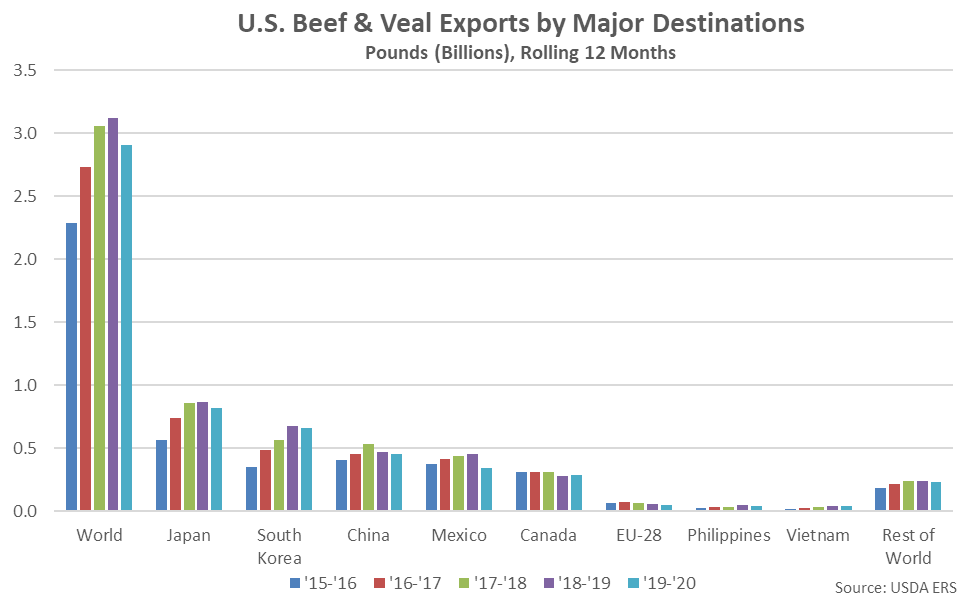 U.S. beef & veal import volumes increased on a YOY basis for the first time in the past three months during Jun ’20, finishing up 15.3% and reaching a five year seasonal high level. Beef & veal import volumes reached a five year high level throughout Jun ’20. Beef & veal import volumes continued to exceed export volumes for the fourth consecutive month during Jun ’20, resulting in U.S. beef & veal trade finishing at a negative level. Jun ’20 beef & veal net trade finished at a four and a half year low level, overall.
’18-’19 annual beef & veal net trade finished at a positive level for the second consecutive year however beef & veal net trade remained 54.2% below previous year levels. ’19-’20 YTD net beef & veal trade has declined to a negative level throughout the first three quarters of the production season.
U.S. beef & veal import volumes increased on a YOY basis for the first time in the past three months during Jun ’20, finishing up 15.3% and reaching a five year seasonal high level. Beef & veal import volumes reached a five year high level throughout Jun ’20. Beef & veal import volumes continued to exceed export volumes for the fourth consecutive month during Jun ’20, resulting in U.S. beef & veal trade finishing at a negative level. Jun ’20 beef & veal net trade finished at a four and a half year low level, overall.
’18-’19 annual beef & veal net trade finished at a positive level for the second consecutive year however beef & veal net trade remained 54.2% below previous year levels. ’19-’20 YTD net beef & veal trade has declined to a negative level throughout the first three quarters of the production season.
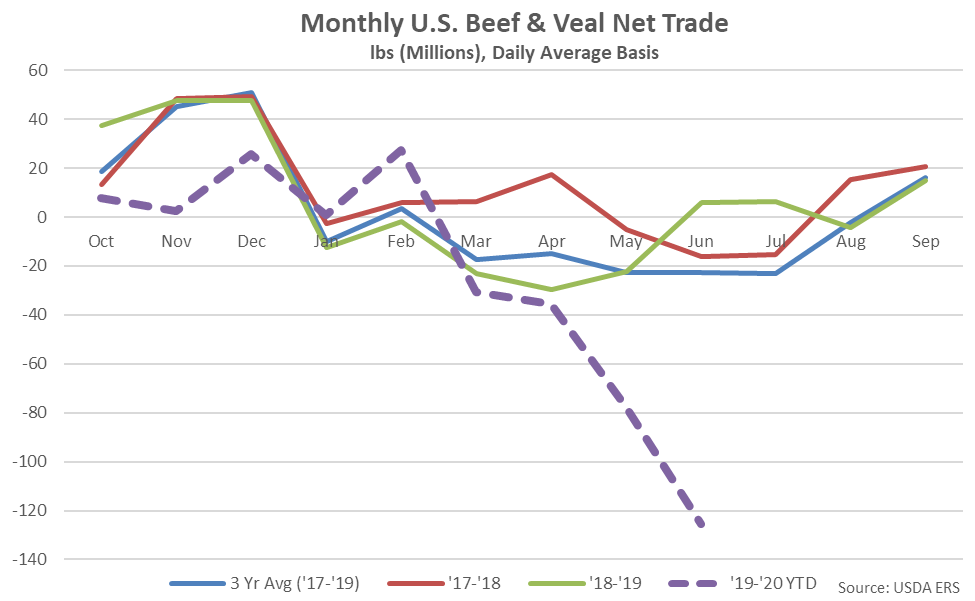 Broilers – Net Trade Declines on a YOY Basis for the Second Consecutive Month, Finishes Down 1.5%
U.S. broiler export volumes finished lower on a YOY basis for the second consecutive month throughout Jun ’20, declining by 1.1%. Broiler export volumes had finished higher on a YOY basis over seven consecutive months prior to the two most recent declines. YOY declines in U.S. broiler export volumes were led by shipments destined to Cuba, followed by volumes destined to Angola, while export volumes destined to China, Hong Kong & Taiwan increased most significantly on a YOY basis throughout the month.
Broilers – Net Trade Declines on a YOY Basis for the Second Consecutive Month, Finishes Down 1.5%
U.S. broiler export volumes finished lower on a YOY basis for the second consecutive month throughout Jun ’20, declining by 1.1%. Broiler export volumes had finished higher on a YOY basis over seven consecutive months prior to the two most recent declines. YOY declines in U.S. broiler export volumes were led by shipments destined to Cuba, followed by volumes destined to Angola, while export volumes destined to China, Hong Kong & Taiwan increased most significantly on a YOY basis throughout the month.
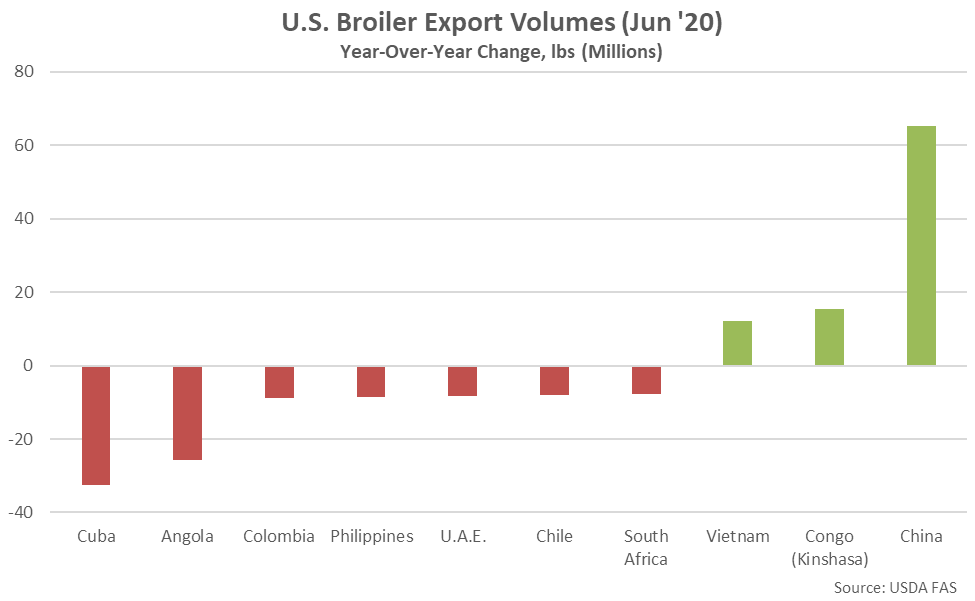 Mexico has historically been the largest importer of U.S. broilers, accounting for over one fifth of the total U.S. broiler export volumes throughout the past five years. Throughout the past 12 months, U.S. broiler export volumes destined to China, Hong Kong & Taiwan have increased most significantly on a YOY basis, followed by volumes destined to Vietnam, while shipments destined to Angola have declined most significantly on a YOY basis over the period.
Mexico has historically been the largest importer of U.S. broilers, accounting for over one fifth of the total U.S. broiler export volumes throughout the past five years. Throughout the past 12 months, U.S. broiler export volumes destined to China, Hong Kong & Taiwan have increased most significantly on a YOY basis, followed by volumes destined to Vietnam, while shipments destined to Angola have declined most significantly on a YOY basis over the period.
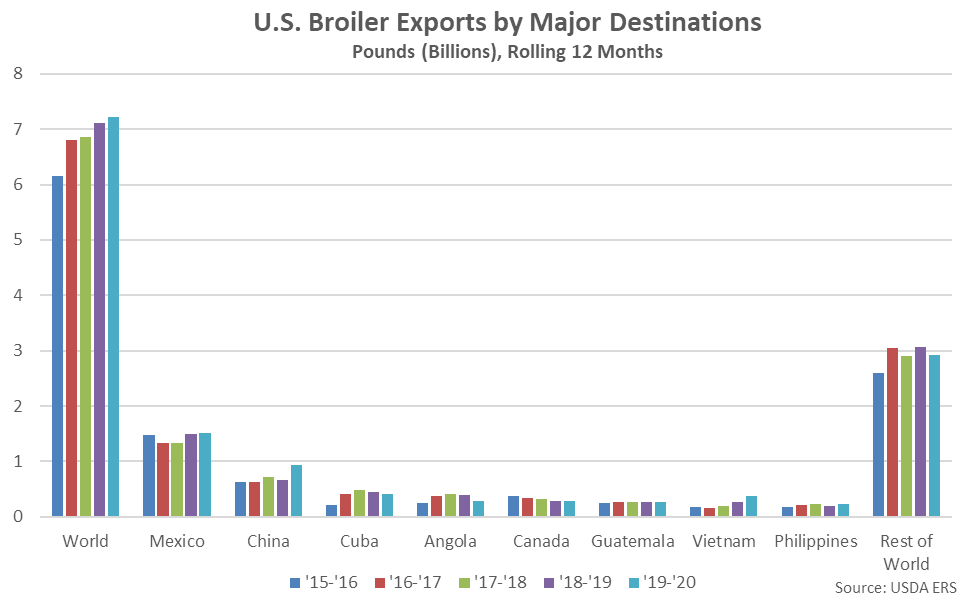 U.S. broiler import volumes increased on a YOY basis for the sixth time in the past seven months during Jun ’20, finishing up 20.9%. Broiler import volumes remained at insignificant levels relative to export volumes, however, as Jun ’20 imports amounted to just 2.3% of export volumes. The YOY decline in broiler export volumes, coupled with the YOY increase in import volumes, resulted in U.S. broiler net trade finishing 1.5% lower on a YOY basis during Jun ’20. The YOY decline in broiler net trade was the second experienced in a row.
’18-’19 annual net broiler trade finished up 1.7% YOY, reaching a five year high, despite declines experienced throughout the final months of the production season. ’19-’20 YTD net broiler trade has increased by an additional 2.7% on a YOY basis throughout the first three quarters of the production season, despite the most recent decline.
U.S. broiler import volumes increased on a YOY basis for the sixth time in the past seven months during Jun ’20, finishing up 20.9%. Broiler import volumes remained at insignificant levels relative to export volumes, however, as Jun ’20 imports amounted to just 2.3% of export volumes. The YOY decline in broiler export volumes, coupled with the YOY increase in import volumes, resulted in U.S. broiler net trade finishing 1.5% lower on a YOY basis during Jun ’20. The YOY decline in broiler net trade was the second experienced in a row.
’18-’19 annual net broiler trade finished up 1.7% YOY, reaching a five year high, despite declines experienced throughout the final months of the production season. ’19-’20 YTD net broiler trade has increased by an additional 2.7% on a YOY basis throughout the first three quarters of the production season, despite the most recent decline.
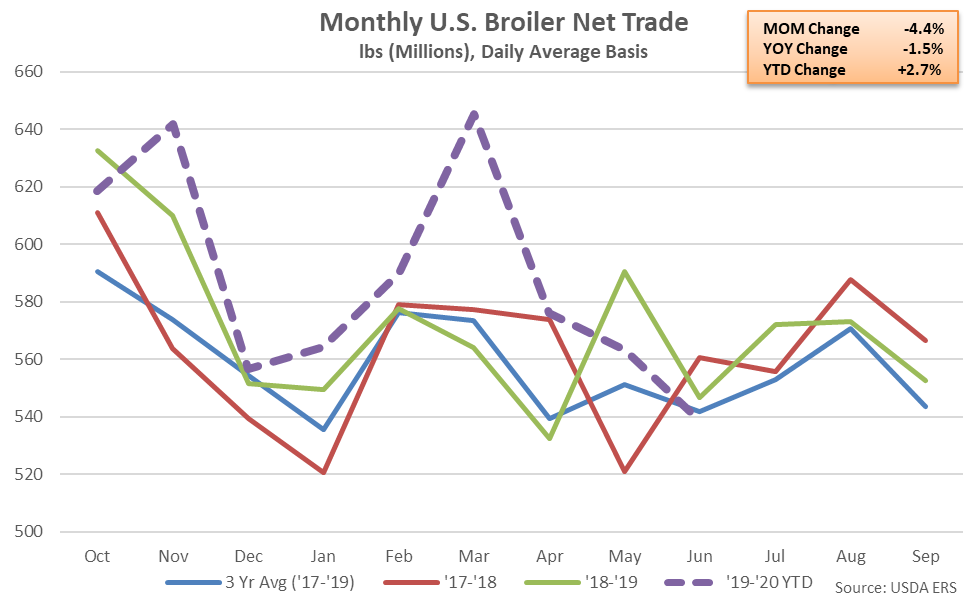 Combined Net Trade
Overall, combined net trade of U.S. pork, beef and broilers declined on a YOY basis for the first time in the past eight months during Jun ’20, finishing down 130.0 million pounds, or 13.3%. The YOY decline in combined net trade of U.S. pork, beef and broilers was the largest experienced throughout the past four and a half years. Combined net trade of U.S. pork, beef and broilers had reached an eight and a half year high growth rate throughout the month of March, prior to decelerating throughout the next several months.
Combined Net Trade
Overall, combined net trade of U.S. pork, beef and broilers declined on a YOY basis for the first time in the past eight months during Jun ’20, finishing down 130.0 million pounds, or 13.3%. The YOY decline in combined net trade of U.S. pork, beef and broilers was the largest experienced throughout the past four and a half years. Combined net trade of U.S. pork, beef and broilers had reached an eight and a half year high growth rate throughout the month of March, prior to decelerating throughout the next several months.
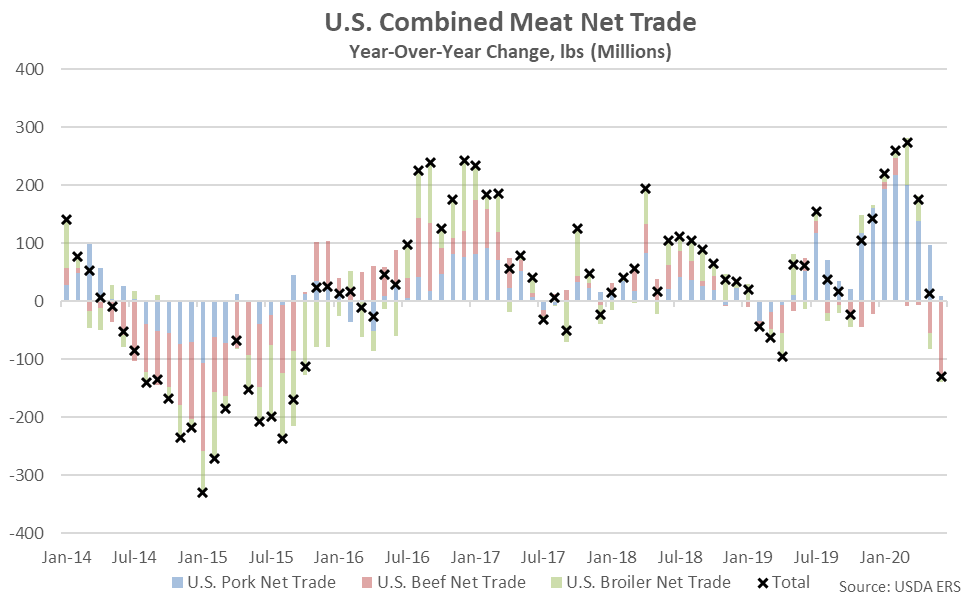
- U.S. net pork trade increased on a YOY basis for the 14th consecutive month during Jun ’20, finishing up 2.3% and reaching a record high seasonal level. Pork export volumes increased 3.3% on a YOY basis throughout the month, driven higher by continued growth in volumes destined to China, Hong Kong & Taiwan. The YOY increase in pork export volumes was the smallest experienced throughout the past 13 months, however.
- U.S. beef & veal export volumes declined to an 11 year seasonal low level throughout Jun ’20, finishing 33.0% below previous year levels. Net beef & veal trade finished at a negative level for the fourth consecutive month, declining to a four and a half year low level, overall.
- U.S. net broiler trade declined on a YOY basis for the second consecutive month, finishing down 1.5%.
 Mexico and Japan have historically been the largest importers of U.S. pork products, accounting for nearly half of the total U.S. pork export volumes throughout the past five years. Combined U.S. pork export volumes destined to Mexico and Japan have declined by 2.9% on a YOY basis throughout the past 12 months, however. Throughout the past 12 months, YOY increases in U.S. pork exports have been led by product destined to China, Hong Kong & Taiwan, while shipments destined to South Korea have declined most significantly on a YOY basis over the period.
Mexico and Japan have historically been the largest importers of U.S. pork products, accounting for nearly half of the total U.S. pork export volumes throughout the past five years. Combined U.S. pork export volumes destined to Mexico and Japan have declined by 2.9% on a YOY basis throughout the past 12 months, however. Throughout the past 12 months, YOY increases in U.S. pork exports have been led by product destined to China, Hong Kong & Taiwan, while shipments destined to South Korea have declined most significantly on a YOY basis over the period.
 U.S. pork import volumes finished higher on a YOY basis for the second consecutive month during Jun ’20, increasing by 8.8%. Pork import volumes had finished lower on a YOY basis over 24 consecutive months prior to the two most recent increases. The increase in pork export volumes more than offset the increase in import volumes, resulting in U.S. net pork trade finishing up 2.3% YOY during Jun ’20, reaching a record high seasonal level. The YOY increase in net pork trade was the 14th experienced in a row but the smallest experienced throughout the period.
’18-’19 annual net pork trade increased 5.6% YOY, finishing at a record high level for the second consecutive year. ’19-’20 YTD net pork trade has increased an additional 30.8% on a YOY basis throughout the first three quarters of the production season.
U.S. pork import volumes finished higher on a YOY basis for the second consecutive month during Jun ’20, increasing by 8.8%. Pork import volumes had finished lower on a YOY basis over 24 consecutive months prior to the two most recent increases. The increase in pork export volumes more than offset the increase in import volumes, resulting in U.S. net pork trade finishing up 2.3% YOY during Jun ’20, reaching a record high seasonal level. The YOY increase in net pork trade was the 14th experienced in a row but the smallest experienced throughout the period.
’18-’19 annual net pork trade increased 5.6% YOY, finishing at a record high level for the second consecutive year. ’19-’20 YTD net pork trade has increased an additional 30.8% on a YOY basis throughout the first three quarters of the production season.
 Beef & Veal – Exports Decline to an 11 Year Seasonal Low Level, Net Trade Remains Negative
U.S. beef & veal export volumes declined on a YOY basis for the third consecutive month during Jun ’20, finishing down 33.0% and reaching an 11 year seasonal low level. The YOY decline in beef & veal export volumes was the largest experienced throughout the past 15 years on a percentage basis. YOY declines in U.S. beef & veal export volumes were led by shipments destined to South Korea, followed by shipments destined to Mexico and Japan, while export volumes destined to New Zealand finished most significantly higher on a YOY basis throughout the month.
Beef & Veal – Exports Decline to an 11 Year Seasonal Low Level, Net Trade Remains Negative
U.S. beef & veal export volumes declined on a YOY basis for the third consecutive month during Jun ’20, finishing down 33.0% and reaching an 11 year seasonal low level. The YOY decline in beef & veal export volumes was the largest experienced throughout the past 15 years on a percentage basis. YOY declines in U.S. beef & veal export volumes were led by shipments destined to South Korea, followed by shipments destined to Mexico and Japan, while export volumes destined to New Zealand finished most significantly higher on a YOY basis throughout the month.
 Japan, South Korea, China, Hong Kong & Taiwan, Mexico and Canada have historically been the largest importers of U.S. beef & veal products, combining to account for nearly 90% of the total U.S. beef & veal export volumes throughout the past five years. Throughout the past 12 months, U.S. beef & veal export volumes destined to Indonesia have increased most significantly on a YOY basis, while shipments destined to Mexico have declined most significantly on a YOY basis over the period.
Japan, South Korea, China, Hong Kong & Taiwan, Mexico and Canada have historically been the largest importers of U.S. beef & veal products, combining to account for nearly 90% of the total U.S. beef & veal export volumes throughout the past five years. Throughout the past 12 months, U.S. beef & veal export volumes destined to Indonesia have increased most significantly on a YOY basis, while shipments destined to Mexico have declined most significantly on a YOY basis over the period.
 U.S. beef & veal import volumes increased on a YOY basis for the first time in the past three months during Jun ’20, finishing up 15.3% and reaching a five year seasonal high level. Beef & veal import volumes reached a five year high level throughout Jun ’20. Beef & veal import volumes continued to exceed export volumes for the fourth consecutive month during Jun ’20, resulting in U.S. beef & veal trade finishing at a negative level. Jun ’20 beef & veal net trade finished at a four and a half year low level, overall.
’18-’19 annual beef & veal net trade finished at a positive level for the second consecutive year however beef & veal net trade remained 54.2% below previous year levels. ’19-’20 YTD net beef & veal trade has declined to a negative level throughout the first three quarters of the production season.
U.S. beef & veal import volumes increased on a YOY basis for the first time in the past three months during Jun ’20, finishing up 15.3% and reaching a five year seasonal high level. Beef & veal import volumes reached a five year high level throughout Jun ’20. Beef & veal import volumes continued to exceed export volumes for the fourth consecutive month during Jun ’20, resulting in U.S. beef & veal trade finishing at a negative level. Jun ’20 beef & veal net trade finished at a four and a half year low level, overall.
’18-’19 annual beef & veal net trade finished at a positive level for the second consecutive year however beef & veal net trade remained 54.2% below previous year levels. ’19-’20 YTD net beef & veal trade has declined to a negative level throughout the first three quarters of the production season.
 Broilers – Net Trade Declines on a YOY Basis for the Second Consecutive Month, Finishes Down 1.5%
U.S. broiler export volumes finished lower on a YOY basis for the second consecutive month throughout Jun ’20, declining by 1.1%. Broiler export volumes had finished higher on a YOY basis over seven consecutive months prior to the two most recent declines. YOY declines in U.S. broiler export volumes were led by shipments destined to Cuba, followed by volumes destined to Angola, while export volumes destined to China, Hong Kong & Taiwan increased most significantly on a YOY basis throughout the month.
Broilers – Net Trade Declines on a YOY Basis for the Second Consecutive Month, Finishes Down 1.5%
U.S. broiler export volumes finished lower on a YOY basis for the second consecutive month throughout Jun ’20, declining by 1.1%. Broiler export volumes had finished higher on a YOY basis over seven consecutive months prior to the two most recent declines. YOY declines in U.S. broiler export volumes were led by shipments destined to Cuba, followed by volumes destined to Angola, while export volumes destined to China, Hong Kong & Taiwan increased most significantly on a YOY basis throughout the month.
 Mexico has historically been the largest importer of U.S. broilers, accounting for over one fifth of the total U.S. broiler export volumes throughout the past five years. Throughout the past 12 months, U.S. broiler export volumes destined to China, Hong Kong & Taiwan have increased most significantly on a YOY basis, followed by volumes destined to Vietnam, while shipments destined to Angola have declined most significantly on a YOY basis over the period.
Mexico has historically been the largest importer of U.S. broilers, accounting for over one fifth of the total U.S. broiler export volumes throughout the past five years. Throughout the past 12 months, U.S. broiler export volumes destined to China, Hong Kong & Taiwan have increased most significantly on a YOY basis, followed by volumes destined to Vietnam, while shipments destined to Angola have declined most significantly on a YOY basis over the period.
 U.S. broiler import volumes increased on a YOY basis for the sixth time in the past seven months during Jun ’20, finishing up 20.9%. Broiler import volumes remained at insignificant levels relative to export volumes, however, as Jun ’20 imports amounted to just 2.3% of export volumes. The YOY decline in broiler export volumes, coupled with the YOY increase in import volumes, resulted in U.S. broiler net trade finishing 1.5% lower on a YOY basis during Jun ’20. The YOY decline in broiler net trade was the second experienced in a row.
’18-’19 annual net broiler trade finished up 1.7% YOY, reaching a five year high, despite declines experienced throughout the final months of the production season. ’19-’20 YTD net broiler trade has increased by an additional 2.7% on a YOY basis throughout the first three quarters of the production season, despite the most recent decline.
U.S. broiler import volumes increased on a YOY basis for the sixth time in the past seven months during Jun ’20, finishing up 20.9%. Broiler import volumes remained at insignificant levels relative to export volumes, however, as Jun ’20 imports amounted to just 2.3% of export volumes. The YOY decline in broiler export volumes, coupled with the YOY increase in import volumes, resulted in U.S. broiler net trade finishing 1.5% lower on a YOY basis during Jun ’20. The YOY decline in broiler net trade was the second experienced in a row.
’18-’19 annual net broiler trade finished up 1.7% YOY, reaching a five year high, despite declines experienced throughout the final months of the production season. ’19-’20 YTD net broiler trade has increased by an additional 2.7% on a YOY basis throughout the first three quarters of the production season, despite the most recent decline.
 Combined Net Trade
Overall, combined net trade of U.S. pork, beef and broilers declined on a YOY basis for the first time in the past eight months during Jun ’20, finishing down 130.0 million pounds, or 13.3%. The YOY decline in combined net trade of U.S. pork, beef and broilers was the largest experienced throughout the past four and a half years. Combined net trade of U.S. pork, beef and broilers had reached an eight and a half year high growth rate throughout the month of March, prior to decelerating throughout the next several months.
Combined Net Trade
Overall, combined net trade of U.S. pork, beef and broilers declined on a YOY basis for the first time in the past eight months during Jun ’20, finishing down 130.0 million pounds, or 13.3%. The YOY decline in combined net trade of U.S. pork, beef and broilers was the largest experienced throughout the past four and a half years. Combined net trade of U.S. pork, beef and broilers had reached an eight and a half year high growth rate throughout the month of March, prior to decelerating throughout the next several months.
